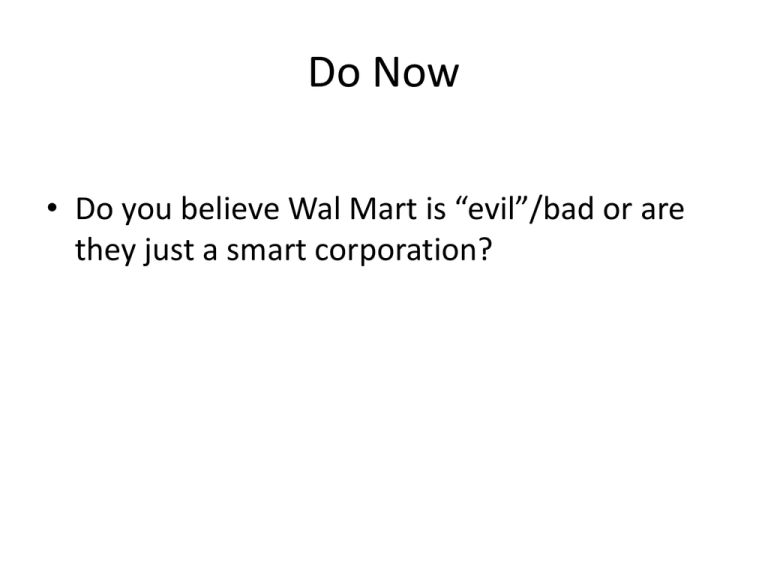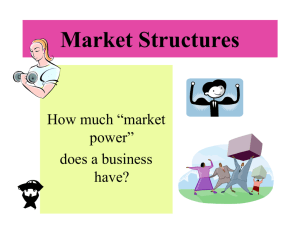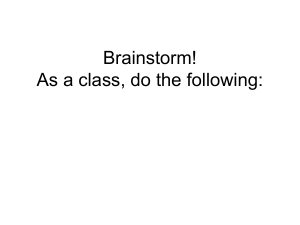Models of Competition
advertisement

Do Now • Do you believe Wal Mart is “evil”/bad or are they just a smart corporation? Models of Competition Market Structure Models of Competition • Def: a description of the type of market that a particular business or industry operates in. • Also know as Market Structure. 4 Types of Models of Competition 1. 2. 3. 4. Perfect competition Monopoly Monopolistic competition Oligopoly Perfect Competition • Def: A market structure in which a large number of firms (businesses) produce the same product Four Conditions for Perfect Competition 1. Many buyers and sellers- people have lots of options to choose from when they buy. 2. Identical products – No difference in items they are exactly the same Four Conditions for Perfect Competition (cont.) 3. Informed buyers and sellers- buyers know the prices and qualities of goods. 4. Free market entry and exit- Business can enter and exit the market when they want Types of Businesses • • • • Farmer’s Market - Have many buyers and sellers - Veggies are identical (a carrot is a carrot) - Buyers can compare prices and quality (informed) • - Farmers decide to go or not Are they many perfectly competitive business? • NO- All 4 conditions must be met. • Ex: Products are rarely identical Barriers of Entry • Def- Factors that make it difficult for new firms to enter a market • Start up costs- costs needed to create and enter a market (rent, machines, labor) • Technology- (ex: software and pharmaceutical companies) Monopoly • Def: A market dominated by a single seller. • They take advantage of their monopoly power and charge high prices • Natural Monopoly- Allowed to exist because the market runs better with just one firm Ex: Monroe County Water Authority Government Monopolies • Patents: Licenses that give inventors exclusive rights to sell their product for a time. Monopolistic Competition • Def: Many companies compete in an open market to sell products that are similar but not identical Four Conditions of Monopolistic Competition 1. Many firms- little start up costs=lots of firms 2. Few artificial barriers to entry- low barriers 3. Slight control over price- can raise prices because products are a little different. 4. Differentiated products-Can distinguish their product from others What Types of Businesses are Monopolistically Competitive? • • • • • • Lots! Most markets exist in this model. Ex. Soft Drinks- Coke Pepsi, Wegmans, etc 1. Many firms (choices) 2. Inexpensive to produce (few barriers) 3. Coke more expensive (control Price) 4. Some like Coke more than Pepsi (different products) How to get customers? • Through Nonprice Competition : a way to attract customers through style, service or location but not a lower price. 4 Types • 1. Characteristics of Goods: Firms distinguish products through size, color taster etc. • 2. Location of Sale -Convenience stores • 3. Service Level- Can charge higher price because they offer a higher level of service. Ex McDonalds vs Fancy rest. • 4. Advertising Image- Advertising creates differences between products Monopolistic vs Perfect Comp. Perfect Competition Monopolistic Competition Prices Lower, firms have no control Higher, firms have some control Profit Lower Higher in short term, but must work hard to keep ahead of rivals Cost and Variety Low costs, no variety (identical products) Higher costs for differentiation, wide variety Oligopoly • Def: A market dominated by a few, large firms • Ex: Cartels • OPEC (Organization of Petroleum Exporting Countries)- Countries that control the oil supply and manipulate prices of gas How do they work? • Collusion- Agreement between members to set prices and production levels • Price Fixing- Agreement to sell at the same or similar prices • Both are illegal in US Do Now • Please answer the following questions: • 1) Describe the term monopoly • 2) What is the MAIN difference between monopolistic and perfect competition • 3) What are some barriers of entry to start a business? • 4) How do Cartels hurt competition? Market Power • Def: the ability of a company to control prices and output • Markets dominated by monopolies and oligopolies have great market power • Markets with many sellers (mono and perfect comp) have little to no market power Predatory Pricing • Def- setting the market price below cost levels for the short term to drive out competitors. Firms in perfect comp. and mono comp. do this to gain market power Ex: Open up my pizza shop and sell slices for $1 even though it costs $1.50 to make. I can raise the price later if I drive out competition. Government and Competition • The Government keeps firms from controlling prices and supply of important goods. Antitrust Laws are laws that encourage competition and break up monopolies/oligopolies in the marketplace. 4 Forms of Anti-Trust Laws 1. Regulating Business Practices-gov’t intervenes if too powerful 2. Breaking Up Monopolies- (Standard Oil AT&T) 3. Blocking Mergers- Can stop them 4. Preserving Incentives-must show benefits to consumer Deregulation • Def: The removal of some government controls over a market. It is used to promote competition. • Allows for more competition, lower prices, increase in variety but can lead to layoffs and business closings • EX: Airlines in the 80’s









